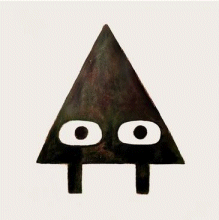Triangle
Mac Barnett
Jon Klassen
Walker Books, UK, 2017
48pp., hbk., RRP $A24.99
9781406376678
Triangle lives in a triangular house with a triangular door. One day he decides to visit his friend Square and play a sneaky trick on him. He walks past lots of triangles – small, medium and big – and past a lot of others that weren’t triangles any more until he got to a place where there were many squares. When he finally gets to Square’s house he plays his sneaky trick, hissing like a snake because he knows Square is afraid of snakes.
But he gives the game away when he is laughing so hard Square discovers him. After glaring at each other Square chases Triangle all the way home – back past the squares, the shapes with no names and the triangles – and has the last laugh. Or does he?
Often the simplest ideas and illustrations create the best stories and that is definitely the case with this, the first in a trilogy of stories about sneaky shapes. Mac Barnett has crafted a charming story that will intrigue and make young readers think, while Klassen’s iconic muted illustrations allow the storyline and the main characters to shine while still being a critical part of the tale. Being able to convey everything through just the shape and position of the eyeballs is proof of a master at work and will encourage the reader to look even more closely at the illustrations, building those critical concepts about print that are so vital for early readers.
Perfect as a standalone, readalong story that will become a favourite, it also offers lots of things to talk about such as shape recognition but could also extend the more curious with question like “Why aren’t they triangles any more? What might have happened?” or “What would you call the shapes without names?” And the question posed on the final page will elicit a vigorous discussion as well as predictions about what will happen next. There might also be a philosophical discussion about whether Triangle and Square are friends and whether this is what friends do to each other. Why did Triangle want to trick Square; how sometimes the prankster doesn’t realise the impact the prank is having and is it possible to still be friends if someone plays a prank on you?
Young children will delight in creating their own versions of Triangle and Square, perhaps as stick puppets, and making up their own adventures to tell.
Looking forward to the next in the series…

